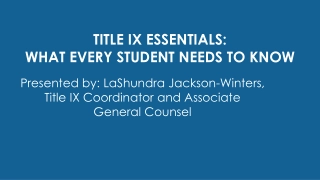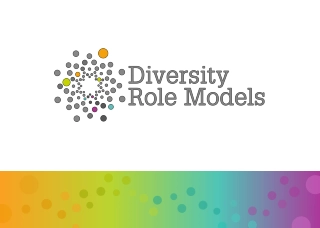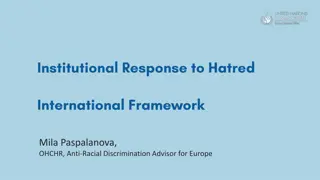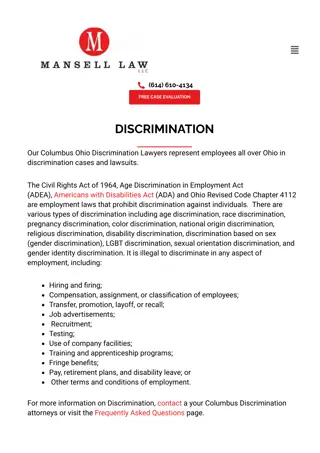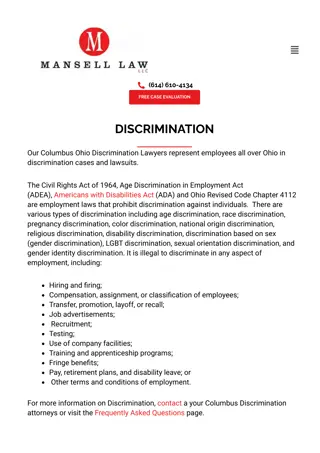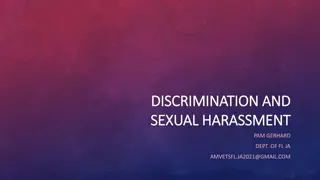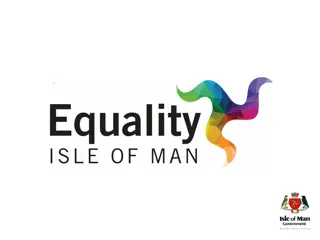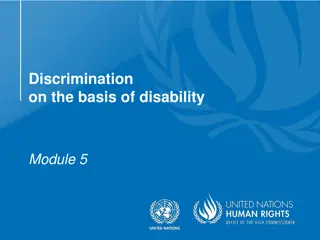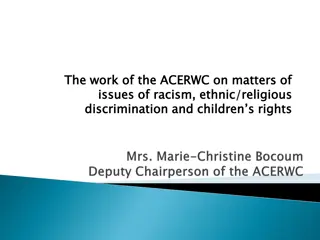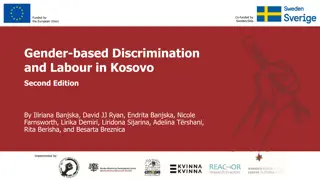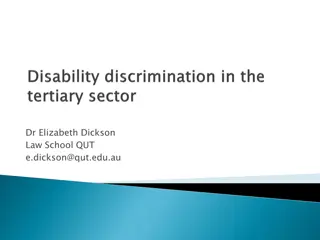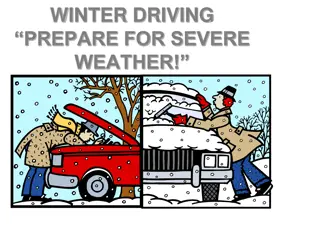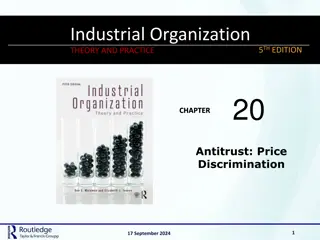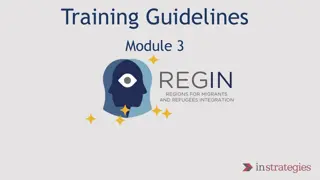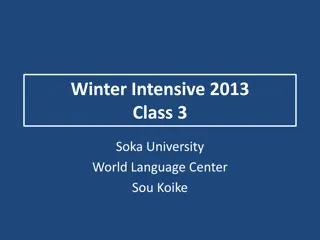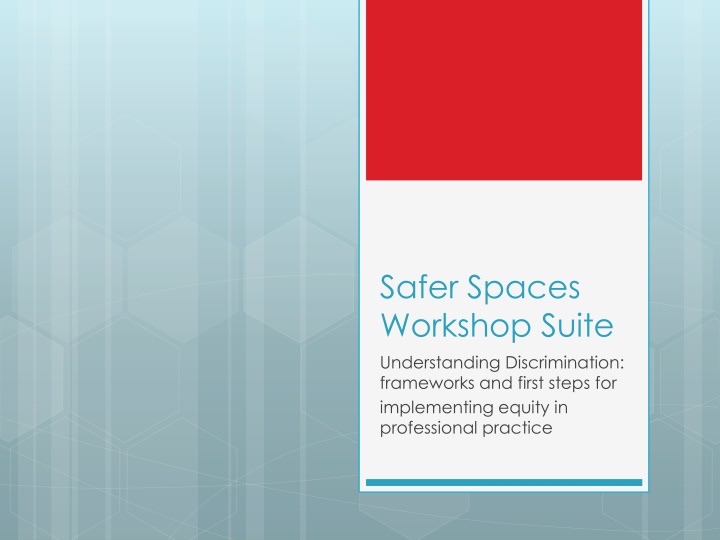
Discrimination: Frameworks and First Steps for Equity in Professional Practice
Join the Safer Spaces Workshop Suite to delve into understanding discrimination and implementing equity in professional practice. Facilitated by Equity Educational Advisors, this workshop offers valuable insights and tools for creating inclusive environments. Explore terminology, scenarios, policies, and more to enhance your knowledge and skills in promoting diversity and equity.
Download Presentation

Please find below an Image/Link to download the presentation.
The content on the website is provided AS IS for your information and personal use only. It may not be sold, licensed, or shared on other websites without obtaining consent from the author. If you encounter any issues during the download, it is possible that the publisher has removed the file from their server.
You are allowed to download the files provided on this website for personal or commercial use, subject to the condition that they are used lawfully. All files are the property of their respective owners.
The content on the website is provided AS IS for your information and personal use only. It may not be sold, licensed, or shared on other websites without obtaining consent from the author.
E N D
Presentation Transcript
Safer Spaces Workshop Suite Understanding Discrimination: frameworks and first steps for implementing equity in professional practice
Welcome! Your facilitators for today are: Sarah Malik - Equity Educational Advisor (anti-racism and cultural diversity) Tynan Jarrett Equity Educational Advisor (Gender Identity and Sexual Orientation)
McGills SEDE Office The Social Equity and Diversity Education office is responsible for education around issues of equity, discrimination and difference at McGill The Equity Educational Advisors work with staff, faculty, and students to provide educational opportunities and resources, to consult on programs and policies, and to build supportive communities
Workshop Overview Introduction Terminology Frameworks and Basics Scenarios Policies at McGill Summary and Evaluation
Background Information Safer Spaces Suite builds on the Safe Space workshop created by the Queer Equity Subcommittee Understanding Discrimination is the most frequently requested workshop, most difficult to deliver Evaluation and redesign: feedback needed!
Some notes about the space Move up, move up. We can t be articulate all of the time We welcome contributions based in many forms of knowledge or experience practical, academic, emotional, and more. We re all here! The facilitators will act as timekeepers for this session they may need to interrupt at some points. What s learned here leaves here, what s said here stays here. Other thoughts?
Terminology: Equity synonymous with fairness, justice, and integrity outcomes of recognition and resources in addition to dignified treatment subjective, determined mainly through perception; no fixed measure of equity not simply identical or equal treatment; treating people differently so all can have the same chances
Terminology: Diversity Describes the presence of difference within any collection of people; refers to the differences amongst all of us, not simply to those of us who differ from an arbitrary norm Diversity might include reference to our bodies, our thoughts or beliefs, the way we relate to other people, our levels of access, or how we express ourselves In discussions of social equity and social diversity, it is important to remain conscious of intergroup inequality and social and historical context
Terminology: Accommodation An adjustment or adaptation that is made when a person s needs are not met by existing policies, practices, and procedures, and structures A way of increasing comfort and facilitating performance
Terminology: Inclusion Ensuring that people can participate in our institutions, programs, etc Recognizing and removing barriers to participation The willingness to change our institutions, programs, etc so that they reflect a different us
Terminology: Oppression Structural and resource restrictions that limit outcomes, hopes, and possibilities; these limitations may continue from generation to generation A person with membership in many groups can be said to have an intersectional identity(i.e. not black sometimes and a woman sometimes, but a black woman all the time); oppression can have specific effects for different intersectional populations Deeper than prejudice, being singled out, or other identity-centered negative experiences many of us share; oppression is related to historic and present- day inequalities wherein one group has dominance and power over another
Thinking About Social Inequality The goal of social justice education is to enable people to develop the critical analytical tools necessary to understand oppression and their own socialization within oppressive systems, and to develop a sense of agency and capacity to interrupt and change oppressive patterns and behaviours in themselves and in the institutions and communities of which they are a part. - from Teaching for Diversity and Social Justice, pg. 2
Five features of oppression Pervasive (over-arching, sewn-in , self- reinforcing) Multiple manifestations (the isms , no hierarchy of oppressions, overall dynamics are similar) Consequences for everyone (privilege and disadvantage) Operates on multiple levels and dimensions We re socialized to accept as normal
Multi-Dimensional Model Social inequality and oppression are maintained and operationalized in three dimensions: The contextual (three levels at which oppression and social inequality function: individual, institutional, and social/cultural) The conscious/unconscious (describes how oppression is both intentional and unintentional) The applied (how oppression and social inequality manifest themselves at each contextual level)
18 Contextual Dimension: Individual Level The individual level of thoughts, feelings, attitudes and actions attitudes, and actions that reflect prejudice against a social group Also refers to practice, individual workers interacting with individual clients Prejudice, the inflexibility of mind which stands in the way of fair and non- judgemental practice.
19 Contextual Dimension: Institutional Level Policies, laws, rules, norms and customs enacted by organizations and social institutions that disadvantage some social groups and advantage other social groups. The ways in which oppression and discrimination are insitutionalized and thus sewn in to the fabric of society. The network of social divisions and the power relations that are so closely associated with them. These institutions include religion, government, education, law, the media, and the health care system It denotes the wider level of social forces, the sociopolitical dimension of interlocking patterns of power and influence.
20 Contextual Dimension: Societal/Cultural Social norms, roles, rituals, language, music, and art that reflect and reinforce the belief that one social group is superior to another Culture: shared ways of seeing, thinking and doing. Shared meanings The cultural level is a complex web of taken-for-granted assumptions of unwritten rules : Values and patterns of thoughts and behaviour, an assumed consensus about what is right and what is normal; it produces conformity; to social norms, and comic humour acts as a vehicle for transmitting and reinforcing this culture Culture is very influential in determining what is perceived as normal in any given set of circumstances.
21 Imagine an iceberg
The Applied Dimension How do oppression and social inequality manifest themselves? Individual level: attitudes and behaviours Institutional level: policies, practices, and norms Societal/Cultural level: values, beliefs and customs
The Conscious/Unconscious Dimension Individual level: conscious attitudes and behaviours; unconscious attitudes and behaviours Institutional level: unconscious institutional norms; conscious institutional policies, conscious institutional laws Societal level: conscious or unconscious norms, beliefs, and values
Scenarios Get into groups of 3 or 4. Please try to work with people you have not yet interacted with very much. Discuss the scenario on the screen or handed out to you as a group. Please pay particular attention to developing the particular language you might use in a given situation We will debrief these scenarios as a group.
Scenario 1: Organizing an Event You have been charged with organizing a conference for your unit or department. The conference will take place in Spring 2013, and coincides with McGill s release of the Action Plan for its Principal s Task Force on Diversity, Excellence and Community Engagement. The head of your department stresses to you the importance of making the conference an inclusive one that reflects well on your department in light of shifting university priorities towards creating a more diverse and welcoming campus environment.
Scenario 1 Questions a) In the planning process, huge events are broken down into smaller tasks and phases of organization in order to make planning more manageable. What is the best stage in the planning process in which to consider questions of inclusivity? Why? b) Make a list of the considerations that might come into play as you attempt to make your event inclusive. How might you begin to address some of these issues? c) In this particular scenario, you were charged with organizing an inclusive event. How similar or different would the considerations of inclusivity be if instead you were writing a policy? Designing a new minor? Explain.
Scenario 1: Debrief Food Alcohol Physical Accessibility: http://www.mcgill.ca/equity_diversity/lgbtq- resources-and-programs/washrooms ; http://www.hrsdc.gc.ca/eng/disability_issues/doc/g pim/guide.pdf Scheduling: http://www.interfaithcalendar.org/2012.htm ; http://www.rapliq.org/en/2010/12/15/the-leisure-to- be-forced-to-stay-at-home/ Cultural Accessibility
Scenario 2: Conflict with Student Over lunch, your colleague Helena tells you about a recent interaction with a student that she found challenging. Helena tells you that a student came to her office after they had exchanged a few e-mails to schedule an appointment. Upon his arrival at her office, Helena says, she rose to greet the student and shake his hand. The student did not extend his own hand, saying I m sorry, I am a Muslim. I cannot shake your hand. Helena tells you that she felt offput, as though the student had discriminated against her on the basis of her gender. She says she completed the appointment, but did not feel comfortable working with the student and wished she had said something about the treatment. The rest of their interaction was brief and to-the-point. Helena asks how you would have handled the situation.
Scenario 2 How would you have handled the situation if you had been in Helena s place? What responsibilities do you have towards the student in this situation? To yourself? What might you say to Helena?
Scenario 2: Debrief Things to consider: As a professional in a student service role, Helena has a responsibility to provide service to all students. Students seeking services have less power than staff who have more institutional access and mediate the provision of services While safety and respect are necessary for all staff to do their work, respect can take many forms, and greater cultural awareness can help us to understand the forms respect might take.
Scenario 3: microaggression Microaggressions are brief, commonplace words or actions that communicate an underlying negative message that relates back to a stereotype about a marginalized group. In many cases. The deliverer of a microaggression may not intend to cause harm of even be aware that harm was caused. A microaggression can relate to any of the isms , ie. sexism, racism, ableism, etc.
Scenario 3: microaggression An example: Angela, an Asian-Canadian student, is in a meeting with her advisor. After a positive meeting with Jane that goes on for forty- five minutes, Jane ends the meeting by shaking Angela s hand and stating, You know you speak excellent English. Angela leaves the meeting feeling frustrated and disconnected.
Scenario 3 What is the underlying message associated with this microaggression? What are the potential impacts of this microaggression for Angela? For Jane? What barriers might Angela face when considering whether or not to raise the issue with her supervisor? Given that microaggressions are an inevitable part of daily life, and are often outside of the realm of conscious awareness, what steps can we take to lower the frequency with which we deliver microaggressions? a) b) c) d)
Scenario 3: Debrief To consider: People from marginalized groups face these kinds of microaggressions regularly, sometimes multiple times per day or week, for their entire lives there is an aggregate effect. The impacts of a microaggression can take up valuable mental and emotional energy, and distract students from other parts of life. Because the deliverer is often unaware of the bias they have communicated, raising the issue involves risks of defensiveness and alienation.
Diversity at McGill: Staff From McGill University s Workforce Analysis (WFA) Summary Report (available online: https://www.mcgill.ca/hr/employee/working- conditions/employment-equity/fcp-compliance-review-2010-documents) The following numbers reflect percentages and totals calculated against McGill s total number of 6750 employees, and relative to representation for each designated group (Aboriginal Peoples, Persons with Disabilities, etc.) in the available workforce. Although Women are overrepresented overall (51% of McGill s workforce vs. 48.7% of the available workforce) 105 women are missing from 6 Occupational Groups (OG) 38 Aboriginal Peoples are missing from McGill s workforce, an underrepresentation of 62.5%. 100% absence in 3 OGs, and 33 employees missing in the Professional Group 330 Visible Minority employees are missing, the greatest number (267) in the Professional OG. 181 People with Disabilities are missing from McGill s workforce, with underrepresentation in 12 out of 14 OGs.
Diversity at McGill: Student Body At the moment, very little comprehensive data on McGill s student populations is available Many McGill undergraduate students have reported experiences of discrimination on the basis of gender, sexual orientation, ability, ethnic origin, etc. (see Report on the Quality of Undergraduate Education, SSMU 2010, and the McGill University Student Diversity Survey) Efforts are being made within the university to develop more consistent reporting standards, and to gather more informative data on students experiences of discrimination See the Diversity Survey conducted by the Deputy Provost of Student Life and Learning: (http://www.mcgill.ca/deputyprovost/diversitysurvey)
McGill Policies (Internal) Harassment, Sexual Harassment and Discrimination Prohibited by Law (https://secureweb.mcgill.ca/secretariat/sites/mcgill.ca.sec retariat/files/Harassment-Sexual-Harassment-Discrimination- Policy-on.pdf) Hazing Policy (https://secureweb.mcgill.ca/secretariat/sites/mcgill.ca.sec retariat/files/hazingpolicyenglish.pdf) Student Code of Conduct https://secureweb.mcgill.ca/secretariat/sites/mcgill.ca.secr etariat/files/code-student-conduct-discipline-procedures- 2011sept_1.pdf Employment Equity (https://secureweb.mcgill.ca/secretariat/sites/mcgill.ca.sec retariat/files/Employment-Equity-Policy.pdf)
Recourses Secretariat website https://secureweb.mcgill.ca/secretariat/pol icies/hr/harassmentsexualharassment SSMU Equity http://ssmu.mcgill.ca/representation/ssmu- policies/ssmu-equity/
How to decide Internal/External Informal/Formal Institutional/Non-institutional
42 Some Resources Books Neil Thompson Anti-discriminatory Practice (2006. New York: Palgrave) Hardiman, Jackson, and Griffin Teaching for Diversity and Social Justice, 2nd ed (2007. New York: Taylor and Francis) Frances Henry and Carol Tator, eds. Racism in the Canadian University; Demanding Social Justice, Inclusion, and Equity (2009. Toronto: University of Toronto Press) Articles Diluting Diversity; Implications for Intergroup Inequality in Organizations (http://jmi.sagepub.com/content/8/4/399.refs) Racial Microaggressions in Everyday Life (http://www.olc.edu/~jolson/socialwork/OnlineLibrary/microaggression%20art icle.pdf)
Thank you! Tynan Jarrett and Sarah Malik Equity Educational Advisors SEDE Office equity.education@mcgill.ca 514-398-2176 www.mcgill.ca/equity_diversity

